All About Cream & How to Whip It
From half-and-half to heavy cream, this smooth and rich cooking and baking cornerstone is explained. Now you can case the dairy aisle with confidence. Plus, if you ever wondered about the difference between soft peaks, medium peaks, and stiff peaks, we'll teach you.
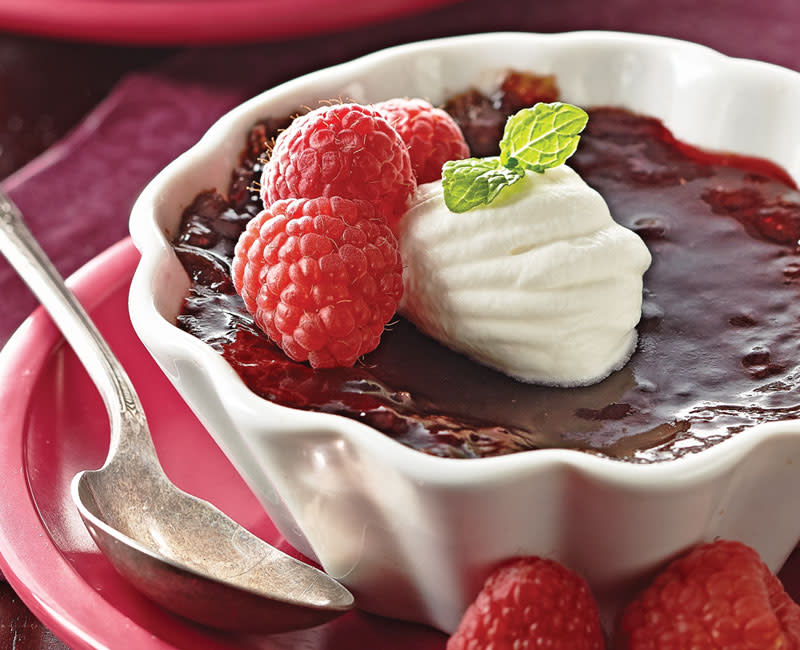
It’s not always obvious what’s in a carton labeled “cream.” In fact, there are a variety of products that fall under this term. Here’s how to know exactly what you’re getting.
What is it? The National Dairy Council defines cream as the highfat layer skimmed from the top of separated milk. It must contain at least 18% milk fat, but can go as high as 40% (whole milk has 3.25%). Some brands may also contain milk or dry milk, emulsifiers, stabilizers, sweeteners, or flavorings.
Processing: Cream products must be sterilized to kill potentially harmful microorganisms. With pasteurization, they are heated to at least 166° for 15 seconds. Ultrapasteurized cream has been heated to 280° for at least 2 seconds. Processors often prefer ultra-pasteurization because it gives products a much longer shelf life than those that are just pasteurized. However, ultra-pasteurization causes cream to whip poorly, so manufacturers compensate by adding emulsifiers, such as carrageenan, to stabilize it. You may find the term “homogenized” on cream and milk products. It’s simply a process that creates uniformity and prevents separation. Cream and milk products are usually homogenized.
Labeling: Ultra-pasteurization is the only processing method that requires labeling. Because of that, you won’t find milk fat percentages on the labels of the various cream products. However, their fat content is regulated and is required to fall into a specific range, see below.
Cooking: Because of heavy cream’s high fat content, it withstands heat well and can be mixed with acidic ingredients without curdling. However, when making cream sauces, a stabilizing ingredient (such as mustard) is often added to prevent separation. Don’t use half & half in place of cream when cooking — its low fat content will cause curdling under high heat.
fat & cream
HEAVY CREAM (or heavy whipping cream) must contain 36% milk fat. The high fat content helps to create excellent volume and makes great whipped cream.
LIGHT WHIPPING CREAM contains less milk fat than heavy cream. When whipped, it won’t hold its volume as long as whipped heavy cream.
LIGHT CREAM has a milk fat content of a rich half & half. It is often used as creamer for coffee or tea and usually can’t be whipped.
HALF & HALF is a blend of milk and cream, and does not have a high enough milk fat content to be whipped. With less than half the fat of heavy cream, it’s usually used as coffee creamer.
how to whip cream
For 2 cups of sweetened whipped cream, you’ll need 1 cup heavy cream, 2 Tbsp. granulated sugar, and 1 tsp. pure vanilla extract. Follow the instructions, below, to whip it to perfection.
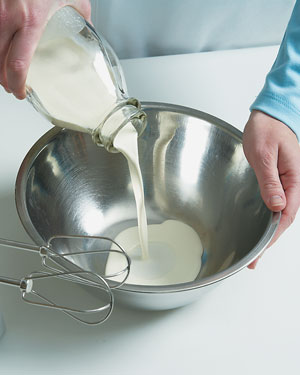
CHILL OUT
To make great whipped cream, be sure the bowl, beaters, cream, and any flavorings are well chilled. (If the fat in the cream gets warm, the volume of the whipped cream will suffer.) First, stir sweeteners, such as sugar, into the cream, then begin beating on medium-high speed.
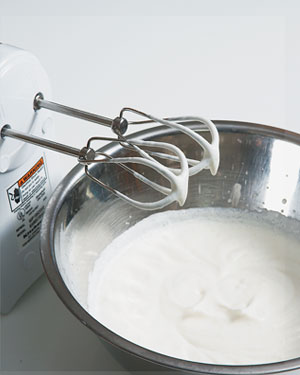
SOFT PEAKS
After about a minute of whipping, the cream will have soft, drooping peaks. At this point it’s super smooth and an excellent consistency for adding to mousse. Liquid flavorings such as liqueurs or extracts can be added now—simply beat until combined.
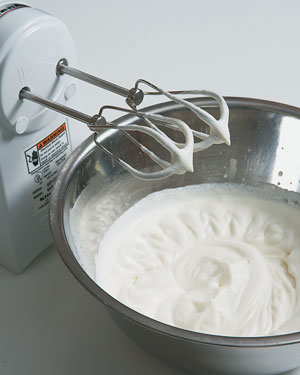
MEDIUM PEAKS
Beaten another 20 seconds beyond soft peaks, whipped cream with medium peaks is very all-purpose in function. It’s still good for folding into pastry cream, puddings, or mousses, or you can use it as a topping for desserts.
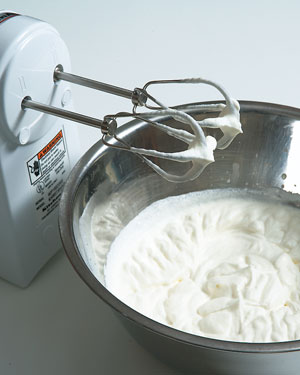
STIFF PEAKS
When heavy cream is whipped to stiff peaks, the fat is well bonded and has more structure. So it’s best served as a topping or used as a filling. Don’t fold it into mousse or pastry cream—you’ll get lumps. If you continue to whip the cream past this point, it won’t be long before the cream turns to butter.
How to Fix Overbeaten Whipped Cream
To restore overbeaten whipped cream, add a little more cold, liquid cream and fold it in by hand.
Product Recommendations
Interested in cooking? Need some supplies?
Check out some of the tools we like. All products featured on Cuisine at Home are independently selected by our editors; we may earn an affiliate commission from qualifying purchases through our links.